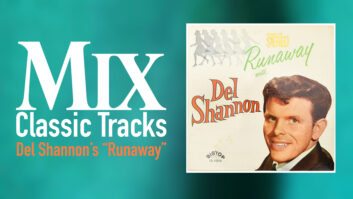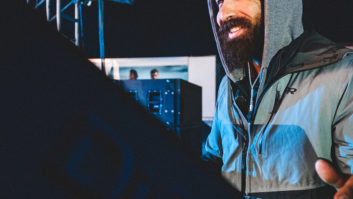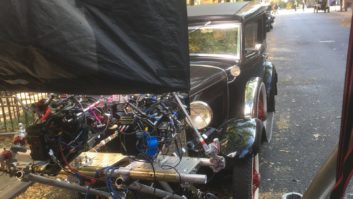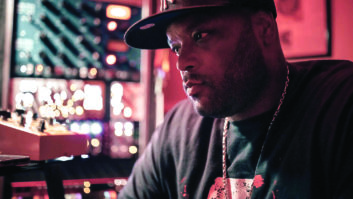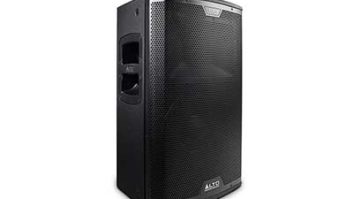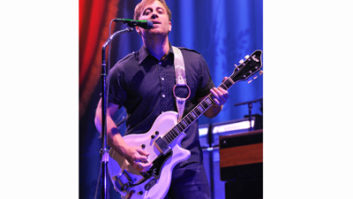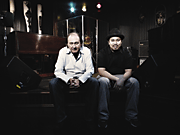
With telltale white headphones dangling from our ears, for a while it appeared that download culture and video blogging might usurp live performance as the musician’s primary means of interacting with audiences and introducing new material. But even as live music venues have struggled to survive in recent years, the emphasis is beginning to return for bands to get out and gig again, to build their careers onstage rather than through record sales.
Almost ironically, it would seem that the Internet age has fueled a number of value-added services that fans love, artists and labels need and only live venues are positioned to deliver. For example, we’ve been seeing a lot of high-end clubs installing multitrack recording gear and HD video-capture systems to complement their standard mixing boards and P.A. systems.
Mozambique’s A/V engineer Tony Tin Nguyen (R) and owner Ivan Spiers
DINNER AND A SHOW
Laguna Beach, Calif.’s Mozambique Steakhouse started to record audio and video of performances when the club first opened in August 2005. Owner Ivan Spiers wanted to capture any magical live events that would occur onstage, allowing his guests to experience the best of South African cuisine and enjoy great musicians like Bill Medley of the Righteous Brothers and vocalist/Rolling Stones sideman Blondie Chaplin.
From the comfortable perch of his well-stocked control room isolated just off from the stage, in-house audio/video engineer Tony Tin Nguyen simultaneously mixes audio and cuts live video in a one-man production effort.
Performances are first mixed through a Yamaha DM2000 console and sent to front of house, as well as directly to a Digidesign Pro Tools HD system for full multitrack audio recording. Four monitor and three in-ear mixes are sent to the stage while the Pro Tools mix is fed to Final Cut Pro 6, capturing audio to video for archiving and streaming to the Internet. Meanwhile, three Sony BRC-300/300P 3CCD color cameras capture HD video — controlled by a Sony RM-BR300 remote — and cut to three camera angles using a Sony DME switcher. An AJA Io box feeds the picture to Final Cut Pro where SATA drives provide more than 3 terabytes of nonlinear storage.
“The Pro Tools mix is also used to feed the live audio signal to private rooms and to the patio for a high-fidelity mix throughout the venue,” says Nguyen, adding that the band can also be seen on any of the club’s 10 LCD (17- to 60-inch) televisions.
Mozambique’s total investment into a full-service live music production setup now tops the $1 million mark, including all A/V equipment, major facility design and an impressive backline: Gretsch “Classic Series” drum kit, SWR bass rig/Goliath 4×10 cabinet with SWR Working Head, Steinway grand piano with original ivory keys, B3 organ with Leslie cabinet, Fender Twin Tweed reissue, Fender Deluxe amp, 62 original VOX amps and more.
According to Nguyen, though, the coolest acquisition that the club has made recently is Wirecast 3 HDV for its ability to stream live high-definition audio and video online, and at the same time to record iso views to hard disks for future use.
“Wirecast was actually used to stream the Live Earth Concert, which was the largest audience concert stream ever online, and is ideally what we want — to be able to stream to the masses online,” says Nguyen.
The vision and business angle of the club’s rich and eclectic assortment of goodies came entirely from Spiers, a multifaceted businessman who owns Mozambique Records and Mozambique Studios. Also a musician, Spiers decided to give back to the musical community by creating an outlet for local and international band/artists to be able to come and play at a high-end, upscale venue.
“We did allocate a large budget for entertainment, and the return would be that people would come from everywhere, from all walks of life, to experience fine dining and entertainment under one venue, making it an authentic place [to] visit,” says Nguyen. “And if they physically couldn’t make it, they could be there online.”
Every show gets recorded and musical guests performing for their first time are given one live CD and a one-song DVD as a courtesy. Artists have the option to purchase their audio/video masters and or edit the media with the club’s production facilities. Currently, the recordings are being used only for marketing the entertainment at the Mozambique Steakhouse Website. The club does not sell the recordings, but is open to offering the right artist an opportunity to release their music on Spiers’ record label.
“Being able to make a deal with certain band/artists with their media for distribution is another way of potentially generating revenue,” adds Nguyen.

A recent performance at the Knitting Factory, Los Angeles
REBIRTH OF A LEGEND
The bi-coastal Knitting Factory chain was actually a very early adopter of audio/visual-capture technologies. Dating back to the late 1990s, the company produced a television series called Live at the Knitting Factory, spotlighting its flagship New York City club’s earlier focus on avant-garde and jazz music. At the turn of the millennium, a Los Angeles venue was built from the ground up with a central A/V recording and control hub windowing out into three performance spaces, capable of doing automated shoots of each. But when Jared Hoffman joined Knitting Factory Entertainment as president and CEO in 2002, the company had strayed into the sale of multimedia and was in turmoil.
“This was a classic situation of an organization losing track of its core competencies,” Hoffman recalls. “As a club, we are a great place to aggregate live content, but we are a very bad place to try and get involved into the rights chain that relates to that content, in that there is a web of publishers, labels, artists and various interests that own and control the rights.”
Drawing on his past experience in dealing with and securing rights — as owner of Instinct Records and the man responsible for signing Moby — Hoffman recognized instead that the clubs could perform a very important function and service for artists and labels.

Jared Hoffman of Knitting Factory Entertainment
So in the fall of 2006, a new technological division was launched, and Knitting Factory Digital Services (KFDS) began spec’ing out state-of-the-art HD video-capture systems for both venues. The installs went live in June of 2007, and include some of the first pieces to come out of Sony’s manufacturing plant that allow a single operator to automate and capture up to a seven-camera modular shoot.
“Obviously, because we can install a very sophisticated camera system and amortize it across thousands of nights, it allows us to do for hundreds of dollars what might otherwise require thousands of dollars,” says Hoffman, noting the savings in terms of soundstage rental, bringing in and setting up, hiring video crews, post-production, etc. “So we’re able to use the scale of a fixed-point installation on a stage that some 5,000 bands a year pass across.”
Cameras at the Knitting Factory never get turned on unless the club is asked to do so by the artist. On a work-for-hire basis, KFDS offers completely scalable solutions for all vital promotional needs, along with customized delivery to a variety of broadcast, Web 2.0, wireless and other distribution platforms. This can include manageable streaming solutions through the venue’s Website, a band/label’s site or other. Hoffman sees countless reasons for offering this service, especially to labels that are developing new artists.
“Maybe they want to do a showcase,” he explains. “Well, how often do label showcases end up empty because the execs are too beat, or they’re caught in a meeting and can’t get down there? But they want to excite the marketing staff or distribution staff nationwide. I think it’s sort of a natural add-on for a label to decide, ‘You know what, it’s real cheap — let’s just have the Knitting Factory post the stream and we can invite our staff to get some sense of what the live experience is.’”
Hoffman says that the service aspect could eventually extend to KFE-branded content online such as a monthly series of Top 10 “Knitting Factory Presents” performances — but he insists it would remain entirely for promotional purposes and that the club would not try to monetize artist content.
“We very much see ourselves as an organization with an editorial voice; that’s what our venue is all about,” says Hoffman. “We exist to help introduce audiences to what’s next and what’s new. We don’t want to be in the business of speculating what other businesses’ money may be in because we don’t own the content; we provide services. That’s smart.”

At LiVE, local bands can cut promos and other material from a performance.
HITTING THE AIRWAVES
Located in the heart of Canada’s Capital — Ottawa, Ontario — LiVE Lounge opened its doors in January of 2007 under the namesake of its parent company, LiVE 88.5 FM, a popular alternative-rock radio station of close to three years with a strong local indie community presence.
“It was natural extension of the LiVE brand and was part of our plan from the beginning,” says Scott A. Broderick, general manager, Newcap Radio. “Great brands create places, events and opportunities for their most committed fans to gather.”
What sets LiVE apart from other radio station-owned venues is its integrated recording services. Centered on Digidesign 002 hardware and running Pro Tools 7.1 LE on a MacBook to LaCie external drives, the tracking rig is intentionally modest in size, keeping it completely “plug-and-go” mobile for station demands. Housed more permanently within the racks of the recording booth is a PreSonus FireStudio receiving feeds directly off the FOH board (24-channel Mackie Onyx 80 Series console), making for 16 tracks total of off-the-floor recording. A Telos Zephyr X Stream is installed to transmit “live-to-air.”
“The Pro Tools studio is a huge hit and a wonderful asset for up-and-coming bands that may not have access to that technology on their own. We are pleased with the relationship it has allowed us to forge with the local and indie music scene,” says Broderick, citing examples in which the station was able to cut multiple promos, exclusive on-air features and other fan-centric bonus material, all from a single performance.
As with Mozambique and Knitting Factory, LiVE Lounge does not own or sell any of the recordings they make. Bryan Ruckstuhl, the club’s engineer and booking agent, says the club’s aim is simply to provide bands with creative tools that they can use as they wish. Artists and labels have already employed the service to prepare demos, special live tracks for CDs and bonus downloads, pre-production material for later use in studio tracks and so on.
“It’s not just another gig; it’s being recorded and documented forever, and the fans love it,” says Ruckstuhl. Even more enticing to musical guests is that LiVE Lounge records free of charge, supplying the bands with untouched audio files that they can mix themselves or have the LiVE engineering staff mix, also free of charge. With the services value-added from the perspective of bands and patrons alike, LiVE Lounge’s revenue comes mainly from drinks, rarely the door.
Through its symbiotic relationship, the club uses the recordings to help promote the venue, LiVE 88.5’s radio contests and special events within the community. Being owned by a radio station that can reciprocate by promoting the upcoming shows and play recorded “live tracks” on air definitely makes it an easy choice for bands looking to book. And though the club’s primary focus is currently on audio, adding video recording and production into the fold is something they’re definitely eyeing.
“Like audio, it’s just another tool to provide for bands and separate the venue from others,” says Ruckstuhl. “The days of bands playing venues that don’t meet their expectations are slowly coming to an end. The live show is the most important aspect of their career and bands need and want to work with people who understand this.”
MODEL BEHAVIOR
Looking out five to 10 years, it’s possible to imagine the day when the larger venues might become completely internetworked, similar to how New Years Eve or Grammy parties are currently produced for television. The upside, of course, is that patrons could see a live act or two in person, and also enjoy other acts piped in from distant locations between sets.
”You know, you can do that, and I know that excites a lot of technologists, but I don’t see a lot of consumer demand for it,” says Hoffman. “I just don’t think that’s the real experience. I think the live music industry has grown and is thriving thanks to the Internet, with audiences further and further afield from the major cities getting instant exposure to what’s next and what’s new. Our job as a venue organization is to get out there into those secondary markets and local venues.”
After what he calls a short seven-year blip in recording history, where record companies have tinkered with online initiatives in hopes of solving geographical and technological issues stemming from digital music sharing, Hoffman believes that live music’s primacy is returning. Even more distinctly, he sees live venues becoming an essential brick-and-mortar anchor of the online parts of both social networking communities and band services.
Testament to Hoffman’s optimism is the fact that San Francisco’s Fillmore club is in the process of branching out and becoming a nationwide franchise. “There’s a triangulation that will occur between the live venue on the ground and a place where people can re-coalesce online later to discuss the show, and with Websites that host bands’ own fan sites and services, whether it’s merchandise or their own homepage,” Hoffman notes. “It’s going to be interesting to watch how those relationships shift and form. But those are sort of the three legs of the music industry looking out five years. I don’t see a place for record labels in the end.”
Jason Scott Alexander is a producer/mixer/remixer in Ottawa, Ontario.
